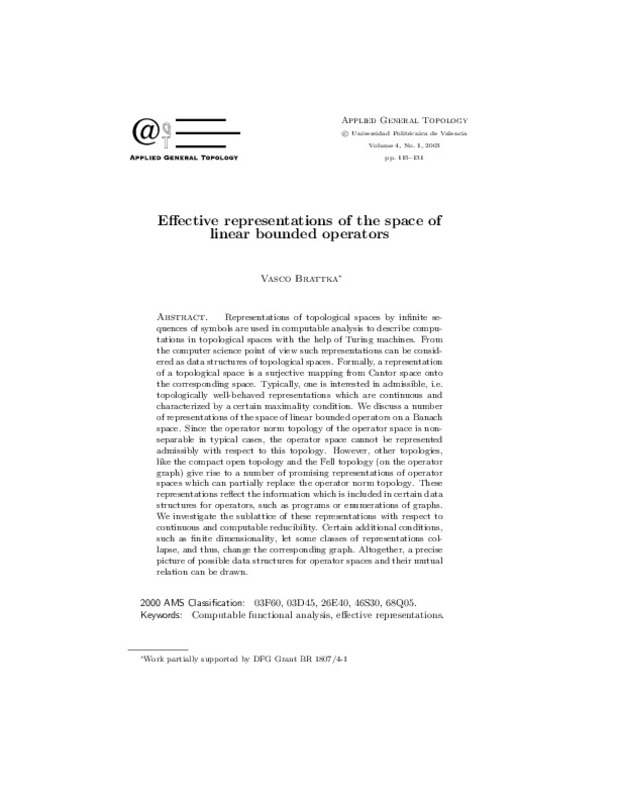JavaScript is disabled for your browser. Some features of this site may not work without it.
Buscar en RiuNet
Listar
Mi cuenta
Estadísticas
Ayuda RiuNet
Admin. UPV
Effective representations of the space of linear bounded operators
Mostrar el registro sencillo del ítem
Ficheros en el ítem
| dc.contributor.author | Brattka, Vasco
|
es_ES |
| dc.date.accessioned | 2017-06-05T08:50:03Z | |
| dc.date.available | 2017-06-05T08:50:03Z | |
| dc.date.issued | 2003-04-01 | |
| dc.identifier.issn | 1576-9402 | |
| dc.identifier.uri | http://hdl.handle.net/10251/82323 | |
| dc.description.abstract | [EN] Representations of topological spaces by infinite sequences of symbols are used in computable analysis to describe computations in topological spaces with the help of Turing machines. From the computer science point of view such representations can be considered as data structures of topological spaces. Formally, a representation of a topological space is a surjective mapping from Cantor space onto the corresponding space. Typically, one is interested in admissible, i.e. topologically well-behaved representations which are continuous and characterized by a certain maximality condition. We discuss a number of representations of the space of linear bounded operators on a Banach space. Since the operator norm topology of the operator space is nonseparable in typical cases, the operator space cannot be represented admissibly with respect to this topology. However, other topologies, like the compact open topology and the Fell topology (on the operator graph) give rise to a number of promising representations of operator spaces which can partially replace the operator norm topology. These representations reflect the information which is included in certain data structures for operators, such as programs or enumerations of graphs. We investigate the sublattice of these representations with respect to continuous and computable reducibility. Certain additional conditions, such as finite dimensionality, let some classes of representations collapse, and thus, change the corresponding graph. Altogether, a precise picture of possible data structures for operator spaces and their mutual relation can be drawn. | es_ES |
| dc.description.sponsorship | Work partially supported by DFG Grant BR 1807/4-1 | |
| dc.language | Inglés | es_ES |
| dc.publisher | Universitat Politècnica de València | |
| dc.relation.ispartof | Applied General Topology | |
| dc.rights | Reconocimiento - No comercial - Sin obra derivada (by-nc-nd) | es_ES |
| dc.subject | Computable functional analysis | es_ES |
| dc.subject | Effective representations | es_ES |
| dc.title | Effective representations of the space of linear bounded operators | es_ES |
| dc.type | Artículo | es_ES |
| dc.date.updated | 2017-06-05T06:50:34Z | |
| dc.identifier.doi | 10.4995/agt.2003.2014 | |
| dc.relation.projectID | info:eu-repo/grantAgreement/DFG//BR 1807%2F4-1/ | |
| dc.rights.accessRights | Abierto | es_ES |
| dc.description.bibliographicCitation | Brattka, V. (2003). Effective representations of the space of linear bounded operators. Applied General Topology. 4(1):115-131. https://doi.org/10.4995/agt.2003.2014 | es_ES |
| dc.description.accrualMethod | SWORD | es_ES |
| dc.relation.publisherversion | https://doi.org/10.4995/agt.2003.2014 | es_ES |
| dc.description.upvformatpinicio | 115 | es_ES |
| dc.description.upvformatpfin | 131 | es_ES |
| dc.type.version | info:eu-repo/semantics/publishedVersion | es_ES |
| dc.description.volume | 4 | |
| dc.description.issue | 1 | |
| dc.identifier.eissn | 1989-4147 | |
| dc.contributor.funder | Deutsche Forschungsgemeinschaft |








